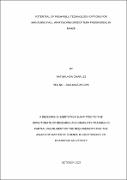| dc.description.abstract | Fall armyworm is a key insect pest of maize. Without proper management, the
pest can cause maize yield losses in the range of 8-21 million tones. It has been
through application of synthetic pesticides, use of natural enemies,
intercropping, use of resistant varieties, and pheromones, among others. Push –
pull technology is generally considered as a cost-effective option for pest
management with minimum negative effects on human health and the
environment. This study aimed at assessing the potential of different push - pull
plant combinations, in managing FAW in maize. Treatments included three plant
combination namely, Desmodium + Brachiaria, Molasses grass + Brachiaria,
Garlic + Brachiaria, and also Sole maize as a control. Molasses grass +
Brachiaria recorded the highest plant height (228.9 ± 0.49cm) while sole maize
+ had the lowest plant height (191.4 ± 1.00cm). For stem girth, molasses grass +
Brachiaria still outperformed the rest (7.3 ± 0.42cm) while garlic + Brachiaria
recorded the lowest (5.6 ± 0.34cm). Similarly, desmodium + Brachiaria recorded
the lowest number of maize plants infested by FAW (5.3 ± 1.2) while sole maize
recorded the highest (31.3 ± 4.2). Desmodium + Brachiaria recorded the highest
maize grain weight (12.6 ± 0.8kg) whereas sole maize had the lowest (5.6 ±
0.2kg). The highest Benefit: Cost (B: C) ratio of (14.1) was recorded in plots of
Greenleaf desmodium + Brachiaria while the lowest (1.1) was recorded in plots
of garlic + Brachiaria. Generally, all push pull plant combinations recorded an
increase in maize growth, reduced fall armyworm damage and increased maize
grain yield in comparison with control. The push-pull plant combination of
Desmodium + Brachiaria outperformed the rest with the highest B: C ratio, and is therefore recommended as the best for consideration in further development
of FAW IPM packages. | en_US |

